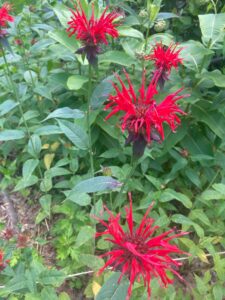If you come to the front door of the Visitor Center this week, two extraordinary– and extraordinarily important– flowers are waiting to greet you, two flowers you should not only know, but plant in your own yards.
The bright blossoms of Monarda, commonly known as bee balm, greet you first, their scarlet red flowers simply impossible to miss. Can a flower ever get more red than this?! That color is a clear signal as to who pollinates it, as hummingbirds are highly attracted to red flowers. Also, check out the long floral tubes, specifically evolved to allow a hummingbird to sip its nectar.
And growing in and alongside the Monarda is my own favorite summer flower, common milkweed, the tall, gangly member of the milkweed clan whose flowers are big pink globes highly reminiscent of a summer fireworks explosion. Last week as I wrote this, the flowers were thinking of opening; this week as you read it, they might be ready and popping. When you visit one, make sure to breathe deeply– this is one of the sweetest nectar-rich plants I’ve ever had the pleasure to poke my nose into.
Monarda, italicized here as this is its scientific name, goes by multiple common names, including wild bergamot, as its crushed leaves smell something akin to the bergamot citrus that flavors Earl Grey tea. But bee balm is another name commonly given to this plant, and my favorite, as the flower’s ecological importance is wrapped up in this name. Not only do hummingbirds crave this flower, but bees do too, especially bumblebees, those native insects and hugely important pollinators that are struggling in the modern world.
Bee balm also has a long history of use as medicinal plants by many Native Americans. The Blackfoot used its leaves in poultices for skin infections and minor wounds, and many First Americans and later colonial settlers used it to alleviate stomach and bronchial ailments. It was also useful in treating mouth and throat infections caused by gingivitis, as bee balm is a natural source of the antiseptic compound found even today in modern commercial mouthwashes.
Oh, and your inner preschooler will LOVE to know that Native Americans also used the plant to prevent excessive flatulence.
So if you plant bee balm in your yard, you’ll be visited by bumblebees and hummingbirds, two wonderful and wonderfully different natural neighborhoods– and you can alleviate your farting problem. Doesn’t get better than this!
Milkweed, as has been written about here many times before over the years, is the exclusive host plant of the monarch caterpillar, mother monarchs laying their eggs only on the very few species of milkweeds that inhabit North America. In fact, just around June 1 I saw an adult monarch laying her eggs on milkweed planted in my own front yard. They’re back!
Monarchs are, of course, the large, orange-and-black butterflies that migrate to Mexico and back, an amazing story that is endangered by multiple issues, including habitat loss, climate change, and, most importantly, herbicides and genetically-resistant GMO crops. Corn and soy are sprayed across huge landscapes, and the crops are able to withstand the chemical assault. But plants like milkweed succumb, and much of the Midwestern corn belt has become a milkweed desert, leading to a 90% crash in monarch overwintering populations in Mexico.
Starting in the 90s, there was a resurgent interest in planting native plants in our yard, and a brilliant “Got Milkweed?” marketing campaign started. But more of us need to plant more of these flowers to buttress those plummeting populations and help save the species.
And the nectar is impossibly attractive for a range of other insects, including all other butterfly species and native bees and pollinators. Plant milkweed and you’ll have a whole ecosystem of pollinating insects buzzing around your yard.
One of the best flowers for your own yard is a cousin of the common milkweed. Nicknamed butterflyweed (Asclepias tuberosa), it grows only a couple of feet tall, but has bright orange flowers that are butterfly magnets. I seriously love this flower– and you will too. And you might also discover that after a female monarch lays her eggs on it, the caterpillar(s) that result may chew all your flower’s leaves; for me, that’s a small price to pay for supporting monarch populations.
So come to the Schuylkill Center soon to go for an early summer nature walk, and introduce yourself to the two flowers growing side-by-side at our front door: Monarda and milkweed, two of the best flowers for increasing the ecological importance of our yards.
By Mike Weilbacher, Executive Director

